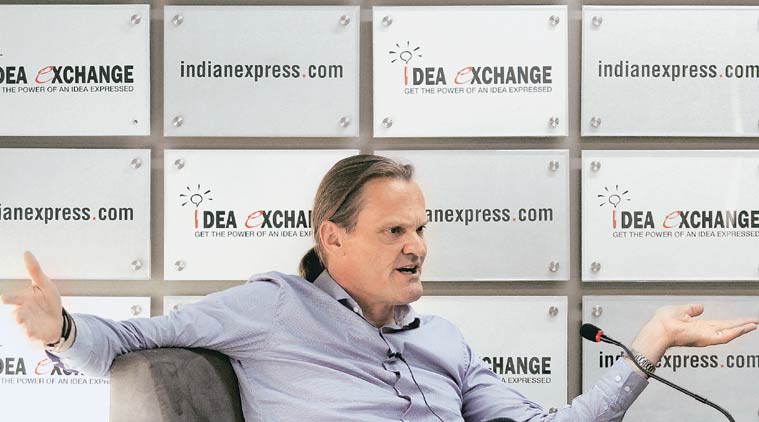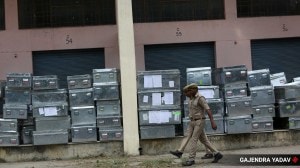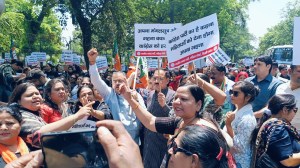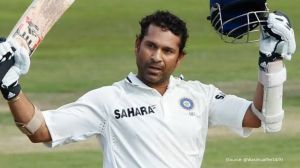- India
- International
‘NGOs are inconvenient at times. But I would rather have an inconvenient NGO than people not having the right to speak’: Onno Ruhl
Country Director for World Bank India Onno Ruhl talks about the difference between UPA, NDA governments and plays down concerns regarding lagging investments.
 ‘People always overestimate how rich India is. India is in the same per capita bracket as Nigeria, Ghana and Kenya,’ says Onno Ruhl. (Source: Express Photo by Praveen Khanna)
‘People always overestimate how rich India is. India is in the same per capita bracket as Nigeria, Ghana and Kenya,’ says Onno Ruhl. (Source: Express Photo by Praveen Khanna)In this Idea Exchange moderated by National Affairs Editor P Vaidyanathan Iyer, Country Director for World Bank India Onno Ruhl talks about the difference between UPA, NDA governments, plays down concerns regarding lagging investments, says even inconvenient NGOs should have the right to speak, and regrets that Indians aren’t aggressive enough towards tackling air pollution.
Why Onno Ruhl?
As the Country Director for World Bank India since 2012, Onno Ruhl has now seen both the UPA and NDA governments in action. He was also the director for operations in the South Asia Region earlier, and has held positions in East and Central Asia as well as Africa. Ruhl served as the country director for Nigeria and manager for the Democratic Republic of the Congo. A Dutch national, he has been the lead private and financial sector development specialist in Africa and Europe and helped create the African Trade Insurance Agency.
P VAIDYANATHAN IYER: You have been country director (India) with the World Bank since September 2012, and have seen both the UPA and NDA governments in action. What differences do you see in the functioning of the two governments?
My most lasting impression of India is the remarkable consensus that there was a deep economic crisis at the time of the general elections. But India was still growing — the lowest (mark) was 4.7 per cent. So my takeaway was that if 4.7 per cent growth means deep economic crisis, then you are really talking about India’s powerful economic potential — despite the government’s inaction. It led me to the conclusion that rather than perfect policies for fast growth, all India needed was a bit of an injection of optimism to grow at 8 per cent. The previous government’s core attitude was, ‘We in India know everything, who are you to say what to do, that is not very interesting’. I was flabbergasted at the hostility to the notion that sharing our experience in other countries could be beneficial to India. But this government is very different. This government has a prime minister who is very ambitious about goals and is very open about the fact that they do not necessarily know how to reach the goals, they just know they have to reach them. So, he has been hammering quite strongly that it is useful for India to learn from what other countries have done.
P VAIDYANTHAN IYER: In the last one year, investments haven’t really picked up. Does the private sector still lack the confidence to invest in India?

I don’t think that is a major problem. Let me go back to Arvind Subramanian’s survey. His basic point was that the private sector will always come in a bit slower than the public sector because fixing the business climate is not so simple. In terms of private investment, the international climate is not so great. In almost all countries, it has been more difficult to convince home-based investors compared to foreign investors, because people from the country tend to be a little more cynical about change happening. But the government has been very aggressive in introducing business reforms, some of them are quick, some very slow. I think the key issue we need to focus on is unlocking public and infrastructure investment and finding a way to deal with the overhang of investments, because it is quite heavy. But it is not rocket science. Mexico and France had similar problems at different points in history and they found a way out of it.
SUBHOMOY BHATTACHARJEE: How do you read the government coming down heavily on the NGO sector?
Honestly, I have difficulty in reading it. I can understand that certain NGOs are uncomfortable for the government. I come from a country (The Netherlands) where the reaction of the government would never be to crack down (on NGOs) because the society wouldn’t accept it. India is not an exception to the category of countries with a slightly different tradition. I personally am of the view that if inconvenience is inconvenience, the best way is to just let it go. NGOs are quite inconvenient at times. But I would still rather have an inconvenient NGO than people not having the right to speak.
COOMI KAPOOR: You have worked in Africa. How would you compare social indicators of India and Africa?
Sadly, the short answer is not very favourable. There are two aspects. One, people always overestimate how rich India is. India is in the same per capita bracket as Nigeria, Ghana and Kenya. If you quiz most people on the Internet, they would say India is quite rich because of what you can see and the Mars satellite. But the truth is some of India’s human development indicators are very poor. The biggest ones are malnutrition and the resultant stunting — this absolutely must be a national priority to resolve. In the last year, stunting at age two has gone from 47 to 38 per cent if I am not mistaken. People say that is great, but I say that is horrible because 38 per cent of kids at two will never be productive in their life. The second one is sanitation. On that front, India fares worse than Bangladesh. I am glad the government understands it. Swachh Bharat is an ambitious undertaking. Sanitation is the only area where we can go to the government and say you can learn from Uganda, but do not insult it. In education, India has made major strides in terms of enrolment, not in terms of quality. There it does not fare that badly compared to Africa.
SUSHANT SINGH: What do you make of the Centre’s slashing of funds for the development sector?
There are two aspects. One is the time-honoured tradition of cutting current expenditure towards the end of fiscal targets. It is a bad practice. When you do that to social sectors, they suffer the most. I do believe investing in capital is extremely important. Some of my predecessors believed all that you needed to do in India was build infrastructure. I disagree. There are just too many people who will not make it, and it is not going to be a good scenario for the country. Regarding the 14th Finance Commission pushing things down — either the Centre is paying less attention to it or they are bringing expenditure close to where the services need to be delivered. The latter is a more benign interpretation. Having worked in federal countries before, like Nigeria, which almost has the same constitution of India in terms of who is responsible for what, I believe it is better to push it down because it is incredibly difficult to set up a ministry in Delhi and deliver a service in Chhattisgarh or any other area. But closing down of taps at the end of the year to meet fiscal targets… hopefully we can get beyond that with better budgeting and a more spread-out expenditure pattern.
ABANTIKA GHOSH: The budget for ICDS (Integrated Child Development Services), the government’s flagship malnutrition scheme, has been halved. Does the World Bank plan to take that up with the government?
Frankly, my key problem with the ICDS is not what its budget is but whether it is doing the right things to solve the problem. If you go to an anganwadi centre, you realise that it can’t really solve the problem of stunting at age two. And when you ask pregnant mothers what happens to the food they get at the centre, you get the saddest answer — they say they give it to their husbands. So I am not sure the ICDS is an effective tool for solving malnutrition. My biggest concern is how do we get a nutrition programme that delivers, and then get a budget for that.
SURABHI: You have spoken a lot about Delhi’s poor air quality. So is the World Bank thinking of any study or of assisting the government in this?
You want 8 per cent growth for poverty alleviation, but how can you grow and not run out of resources? About a year ago, I realised I was coughing but did not know why. Then it became abundantly clear that air pollution in India is very serious, and it is not just Delhi. It is in many cities — Ranchi, Bhopal. The good news is India is one of the few countries that has taken drastic measures in the past for an impact — like CNG. We would like to first help the government — if they want — in having a solid, more effective system to monitor the current situation. Then you can do things that have major impact, things you have to push through — like imposition of better fuels. I think Indian society is really timid in reacting to companies not providing better fuel systems in cars. They say, give us two years. Why not now? I think India is not aggressive enough.
SANDEEP SINGH: Is a smart city a solution to all this?
Smart city is a great forum because it shows you can make urbanisation work. The problem with urbanisation is that it looks bad, messy. But it is actually a great engine for change, and poverty alleviation. People are more easily lifted in the city than the countryside, specially in India, because the plot size for agriculture is so small. And it is more efficient to deliver services in a city because of its density. Now the biggest problem for mankind —and India faces this to a high degree — is a resource challenge to delivering services to everyone. So being efficient in service delivery is very important. Smartening up cities is a very powerful notion. What you are going to do with that notion is another question because planning cities is notoriously difficult, and because the next step would be (having a) stronger, more empowered, more accountable government at the city level, which India constitutionally doesn’t have.
RAKESH SINHA: For over a decade now India has had Maoist insurgency in states which many call India’s ‘heart of darkness’. How does India, given the lack of development in these areas, go about addressing the problem?
We have a lot of experience working in the other ‘hearts of darkness’ and the ultimate ‘heart of darkness’ was Congo. First of all, if you want to fight insurgency, then you will have to increase credibility of the government. You need to create a situation where people perceive that the government is capable of giving them the basics that they want the most. They want security. And then they want some level of local infrastructure. So, as a first step, I would advocate aggressively rolling out community development programmes in the area and making sure that they actually work.
AMITABH SINHA: The government has once again started the cleaning exercise for Ganga river. What is World Bank’s impression of its involvement in the projects?
Well, we were in it with a billion dollars so that is a significant commitment and there are a couple of things about this. First of all, no other country in the history of mankind has been able to clear a river at the level of per capita income that India has. But the real question is how quickly can you really achieve a clean river. I believe the key to that is to focus on some iconic achievements that convince people that success is possible, and it is not so difficult to look for iconic locations on the Ganga. The truth is that it is an infrastructural problem, behavioural problem in terms of how people deal with their waste and trash, and for that you have to bring the river closer to daily life and for re-creational purposes.
How do we feel about our engagement? Little bit frustrated because it is so difficult, it is such a multi-faceted project. But in the end, the basics, mostly basics in the pollution control project, are not that high-flying.
AMITABH SINHA: How is the ease of doing business with this government compared to previous governments?
My friends in the IAS will say no difference. We are still dealing with the IAS, because the gospel is that we deal with the administration and not with the politicians. 99.5 per cent of our interactions are with IAS and state-cadre officers. So it is like how are these people influenced by this government compared to previous governments. It is quite clear and the press has written about it, especially in the beginning, that there was and continues to be a lot of pressure from the Prime Minister and PMO on high-level civil servants to really perform. There is a lot of focus on the goals that have been set. So you can feel that while interacting with the officers, but otherwise it is in fact still the same system.
COOMI KAPOOR: What is the World Bank’s assessment of the efficacy of the National Rural Employment Guarantee Scheme (NREGS)?
First of all it is clear that the NREGS has worked. You would hope from the NREGS that it would work in a low-income space/state. But what we actually found is that it works best in higher-capacity states, and that tells you a couple of things. First that it is a difficult scheme to implement, so where you have higher capacity, it is more successful. Then, the potential of the NREGS versus a normal cash transfer scheme is — one, that it is self targeted, so you have to actually work to get the money; the second part is that the work actually produces some assets and those assets could be valuable to the poor. Now that’s the clear potential of the NREGS compared to any other scheme.
PRIYADARSHI SIDDHANTA: Regional imbalances continue to affect India. Western India generally does well economically and the eastern part lags behind despite huge resources in Jharkhand, Orissa etc.
First of all, that is the very reason why our strategy focuses on low-income states rather than trying to spread it across the whole of India. My own observation is that states do poorly because they have mineral wealth, with the exception of Norway… Congo and Nigeria are countries of fabulous mineral wealth but they don’t actually do so well. But what I think is more convincing is that The Netherlands got into a deep economic crisis when they discovered incredible amounts of natural gas. So the notion that wealth actually causes countries or states to do well, I don’t share at all. The other is impact on fiscal discipline. One of the most industrious countries that I have ever worked in was Armenia. They have actually nothing. That is why they are so industrious because they have no choice but to be industrious. So again this is a personal belief and not some high-flying World Bank report that is well-researched.
SUSHANT SINGH: The World Bank has been in India for close to 68 years. What are the projects that you are really proud of?
We have been very proud to be one of the key players in supporting the Green Revolution. I personally think that we have helped create some notable institutions that have become strong in India, like many of the developed finance institutions started with the World Bank credit line. Historically, I can’t help but mention that the very first loan the World Bank gave to a developing country was in 1948, to India, for Indian Railways. So I hope the dedicated freight coach would be listed in the same list once we complete it, because it is an incredibly important project.
P VAIDYANATHAN IYER: Does the government have any issues about World Bank setting milestones or time frames and conditions for state governments for any of the projects it funds?
Well, we don’t put other conditions but we do agree on time frames. The Government of India is very keen that time frames that are agreed upon are actually kept because the money that is borrowed costs more money because it is not free. So the Government of India and Ministry of Finance are very keen on one thing, that once the loan is taken, it is actually used because that money has an opportunity cost.
Transcribed by Pallavi Chattopadhyay & Pooja Khati
Apr 24: Latest News
- 01
- 02
- 03
- 04
- 05







































